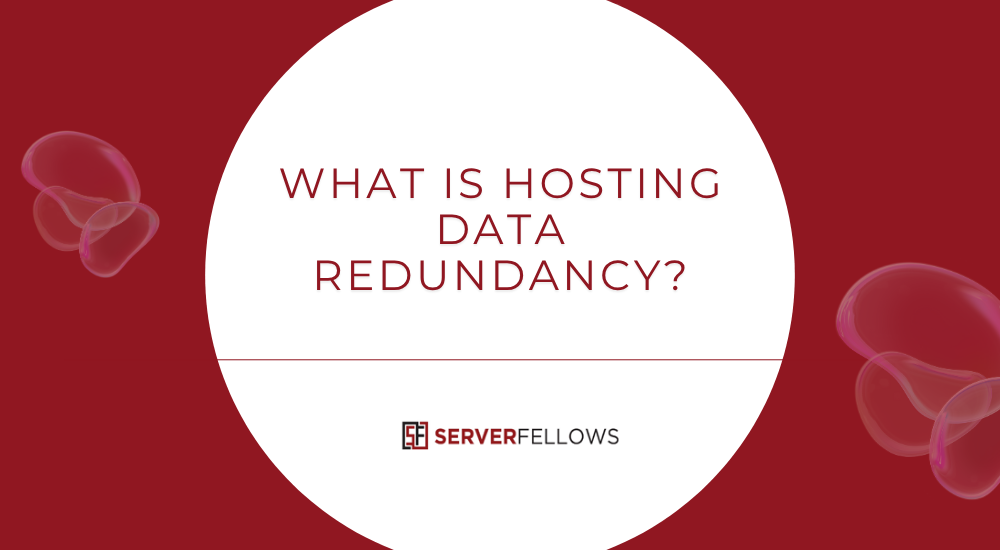
What Is Hosting Data Redundancy?
In today’s digital-first world, data drives every decision, transaction, and customer experience. Losing access to it—even for a few minutes—can disrupt business operations, damage reputation, and cause financial losses. That’s where Hosting Data Redundancy comes in — the silent guardian of your website’s uptime and data integrity.
Understanding Hosting Data Redundancy
Hosting Data Redundancy is the strategic practice of duplicating your data across multiple servers or storage systems to ensure that it remains available and secure, even when one part of your hosting infrastructure fails.
Think of it as having multiple spare keys to your business — if one server or disk fails, another instantly steps in to keep your site online.
At its core, data redundancy is about continuity without compromise. The goal is simple: no downtime, no data loss, and no interruptions.
Experience uninterrupted reliability with Serverfellows.com — where data redundancy meets performance.
How Hosting Data Redundancy Works
The principle behind hosting redundancy is to eliminate single points of failure. It does this by using multiple layers of duplication and real-time synchronization across systems. Here’s how it typically works:
1. Replication Across Servers
Data is continuously copied across multiple servers. This replication can be synchronous (instantaneous mirroring) or asynchronous (near-real-time copying).
If the primary server fails, the replicated server automatically takes over — ensuring zero data loss.
2. Backup Systems
While redundancy is about real-time copies, backups provide an additional safety layer. They store historical versions of data that can be restored in case of corruption, ransomware, or human error.
3. Failover Clusters
A failover cluster is a group of servers configured to act as one system. When one server fails, another server in the cluster automatically assumes its role. This ensures service continuity and prevents downtime.
4. Geographical Redundancy
To prevent loss from regional failures (like natural disasters or power outages), data is stored across multiple geographically separated data centers.
If one region goes down, another instantly takes over — maintaining uninterrupted service availability.
5. Load Balancing and Health Checks
Modern redundancy setups include automated health checks that constantly monitor system performance. Load balancers distribute traffic evenly and reroute it instantly if any node experiences trouble.
With Serverfellows.com, redundancy isn’t just about protection — it’s about performance. Every layer of infrastructure is optimized for uptime and speed.
Benefits of Hosting Data Redundancy
1. Data Protection
Data redundancy ensures your information remains secure and accessible, even in case of system failure. Whether it’s a disk crash or a server malfunction, your data stays safe and recoverable.
2. Guaranteed Uptime
Every minute of downtime can cost businesses money and trust. With redundant hosting, your website stays online through automatic failovers and mirrored environments.
3. Disaster Recovery
Redundancy minimizes the impact of unexpected events such as natural disasters, cyberattacks, or power outages. Since data is stored in multiple locations, recovery becomes almost instant.
4. Business Continuity
When your systems stay up, your business stays running. Redundancy ensures smooth operations for ecommerce platforms, SaaS applications, and corporate websites that rely on constant availability.
5. Enhanced Performance
Redundant systems often improve load speeds and response times by intelligently distributing traffic. This boosts overall website performance and user satisfaction.
Redundancy isn’t a luxury — it’s a necessity. Serverfellows.com integrates redundancy with every hosting plan to keep your business running 24/7.
Types of Data Redundancy in Hosting
Different businesses have different uptime needs. Here are the main redundancy models:
1. Hardware Redundancy
Critical components like power supplies, network cards, and hard drives are duplicated within a single server. Even if one part fails, the other keeps functioning seamlessly.
2. Software Redundancy
Applications or virtual machines are mirrored across servers. This allows seamless failover without manual intervention.
3. Network Redundancy
Multiple network routes ensure data can travel through alternate paths if one connection goes down. This minimizes latency and eliminates bottlenecks.
4. Storage Redundancy
Data is stored in RAID (Redundant Array of Independent Disks) configurations, ensuring that even if a disk fails, no information is lost.
5. Geographic Redundancy
Multiple data centers across regions ensure that localized issues don’t affect the availability of your website or application.
Data Redundancy vs. Backups — Understanding the Difference
While both protect data, redundancy and backups serve distinct purposes:
| Aspect | Data Redundancy | Data Backup |
|---|---|---|
| Purpose | Ensures continuous uptime and data availability | Provides data restoration after loss or corruption |
| Frequency | Continuous or real-time | Scheduled (daily, weekly, monthly) |
| Storage | Multiple live servers | Separate storage system or offline repository |
| Recovery Time | Instantaneous | Slower, requires manual restore |
| Protection From | Hardware or network failure | Human error, ransomware, or accidental deletion |
In essence, redundancy keeps your systems running; backups help you recover if everything else fails.
A solid hosting strategy includes both — real-time redundancy and scheduled backups — for complete peace of mind.
The Importance of Hosting Data Redundancy for Modern Businesses
1. Preventing Downtime
Downtime not only halts business operations but also damages SEO rankings, customer trust, and revenue. Redundancy ensures that your site is always on.
2. Safeguarding Brand Reputation
Customers expect reliability. If your website goes offline, they move on to competitors. Redundancy protects your reputation by ensuring constant availability.
3. Meeting Compliance Standards
Many industries require strict data protection and uptime compliance. Redundant systems help meet these standards effortlessly.
4. Reducing Financial Loss
Every minute of downtime costs money. Investing in redundancy drastically reduces the risk of costly outages.
5. Supporting Scalability
As your business grows, redundancy ensures that new data and servers integrate smoothly without affecting availability.
Why Choose Serverfellows.com for Data Redundancy Hosting
Choosing the right hosting partner can make all the difference. Here’s why Serverfellows.com stands out:
- Multi-layered redundancy: Your data is mirrored across multiple independent systems.
- Failover protection: Automatic switchovers keep your site live during hardware or network failures.
- Geographically distributed data centers: Ensuring resilience and speed across regions.
- Continuous monitoring: 24/7 infrastructure health checks for proactive issue prevention.
- Customizable redundancy options: From small business hosting to enterprise-grade environments.
Whether you’re hosting a personal project or a high-traffic enterprise site, Serverfellows.com provides the reliability and redundancy your business deserves.
Frequently Asked Questions (FAQs)
1. Is hosting data redundancy the same as backup?
No. Backups are static copies made periodically, while redundancy involves live replication to maintain uptime and instant failover.
2. Does redundancy increase hosting costs?
It can, but it saves much more in the long run by preventing costly downtime and data loss incidents.
3. Can small businesses benefit from redundancy?
Absolutely. Even brief downtime can hurt customer trust and sales. Redundancy ensures continuous operations regardless of size.
4. Does redundancy protect against all failures?
It minimizes risks significantly, but it’s most effective when paired with a backup strategy and disaster recovery plan.
5. How can I check if my hosting plan includes redundancy?
Most standard plans mention replication, failover, or mirrored servers. If unsure, consult your provider — or switch to a reliable host like Serverfellows.com.
The Future of Hosting Data Redundancy
As digital infrastructure evolves, data redundancy will become even more intelligent. Automation, distributed cloud systems, and AI-driven monitoring are transforming redundancy from a safety measure into an active optimization tool.
Instead of waiting for failures, systems will predict them — rerouting data and workloads preemptively to prevent downtime altogether. Businesses that embrace redundancy now will lead the future of uptime reliability.
Conclusion: Build Reliability That Never Sleeps
Hosting Data Redundancy isn’t just a technical safeguard; it’s a business essential. It protects your website from downtime, secures your customer data, and ensures your digital presence remains uninterrupted.
Whether you’re running an ecommerce platform, an enterprise portal, or a startup website — redundancy guarantees that your brand never goes offline.
Keep your business always on, always safe, and always fast with Serverfellows.com — where reliability is built into every byte.


